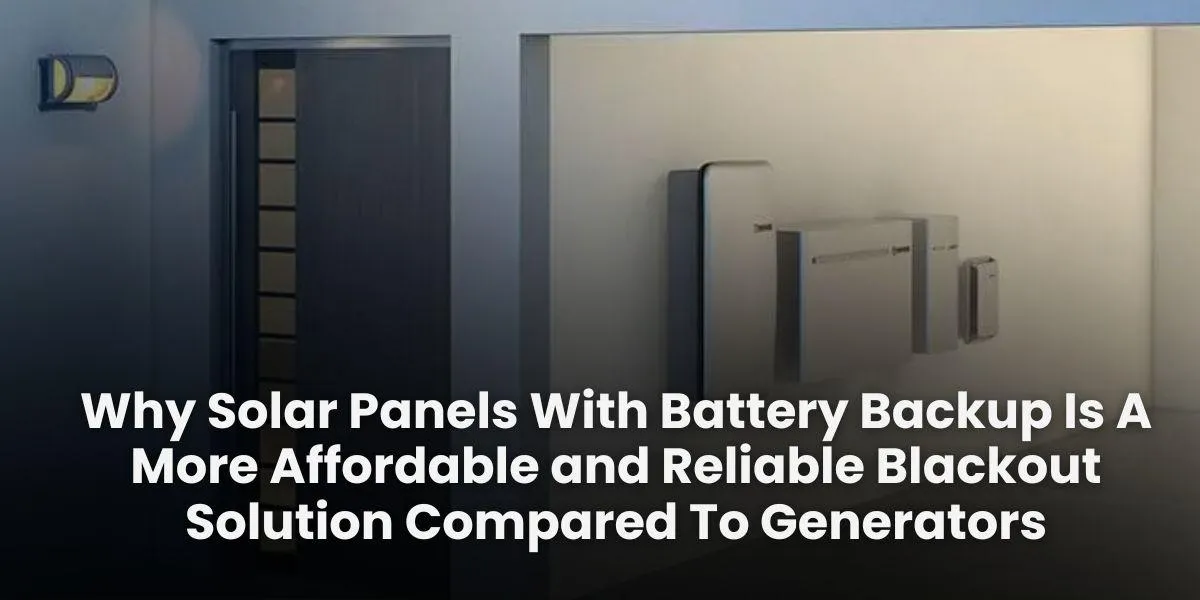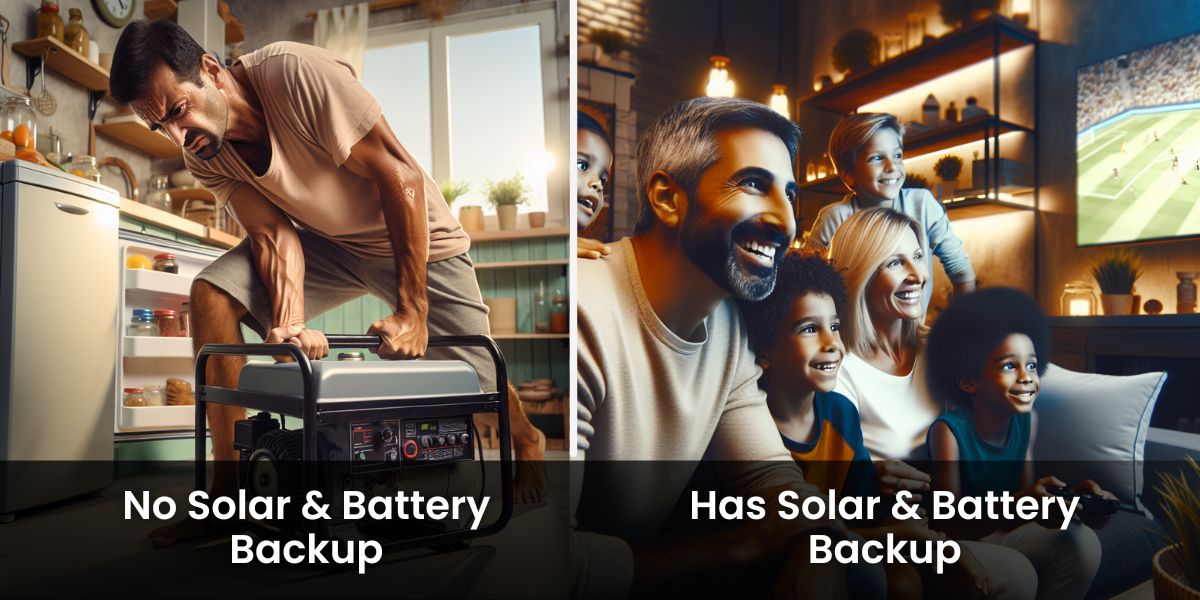BLOG ARTICLES
MY SOLAR SOLUTIONS BLOG

Why Solar Panels With Battery Backup Is A More Affordable and Reliable Blackout Solution Compared To Generators
Have you ever been in a windstorm and the utility company turns off your power to mitigate wildfires? Blackouts can be a real pain, and while many people automatically think of generators, there’s a more sustainable and often more affordable option: solar panels with battery backup.
In this article, we’ll dive into why this setup is not just a trendy eco-friendly choice but a smart financial decision too, making it a more affordable solution for keeping your home powered during outages.
Understanding Blackouts
Common Causes of Blackouts
Blackouts can occur for a multitude of reasons, including severe weather, equipment failure, and accidents that knock out the power grid. Let’s face it; our infrastructure isn’t perfect, and unexpected events can lead to those dreaded power outages.
Impact of Blackouts on Daily Life
When the power goes out, it can have far-reaching effects on our daily lives. From spoiled food to disrupted work schedules and uneasy nights, sudden power cuts leave us feeling vulnerable. Imagine planning a family dinner and suddenly you find yourself eating cold sandwiches in the dark!
Even worse - for residents of Ventura County, California, is that they have experienced power outages for hours on Thanksgiving Day every year for the past four years.

Overview of Backup Power Solutions
To stay powered during a blackout, people generally consider two main solutions: generators and solar panels with battery backup. Both have their pros and cons, but let’s dig deeper.
Generators: The Traditional Backup Option
Generators have long been viewed as the go-to solution for emergency power, especially in situations where the grid fails. They can run on various fuels such as gasoline, propane, or diesel, allowing you to keep essential appliances running during a blackout. However, while generators may seem like a straightforward solution, they come with several significant downsides that can quickly turn your emergency into an added stressor.
Noise and Emissions
First and foremost, let’s talk about noise. Generators can be deafening—imagine trying to relax at home or even sleep with a loud humming machine running in the background. This constant racket can disrupt your peace and can be particularly bothersome for families with children or elderly relatives who need a quiet environment for rest.
Beyond the noise, generators produce harmful emissions, including carbon monoxide, which can pose a serious safety risk, particularly if used indoors or in enclosed spaces.
The idea of bringing a generator inside during a storm can be terrifying, knowing that the very machine meant to provide comfort could instead become a danger to your family’s health and safety.
Fuel Costs and Accessibility
Then there’s the issue of fuel. Generators are not just a one-time investment; they require gasoline, propane, or diesel to operate, and that means ongoing costs. As prices for fuel fluctuate, so do the expenses associated with keeping your generator running.

Imagine the frustration of planning your life around constantly having to refuel your generator every few hours to keep your refrigerator, lights, or heating on.
This can be not only costly but also a logistical nightmare.
What happens if roads are closed, or if the nearest gas station runs out of fuel during an emergency? Having to battle long lines at the pump during a blackout can quickly shift your focus from safeguarding your home to scrambling for resources, adding unnecessary stress to an already tense situation.
Maintenance
It's also essential to recognize the maintenance requirements associated with generators.
These machines need regular checks to ensure they function properly when you need them most. This means changing the oil, checking the spark plugs, and ensuring there’s no buildup of debris that could restrict airflow. For many people—especially those already dealing with the stress of a power outage—this maintenance can feel overwhelming. The last thing you want to worry about during a storm is whether you remembered to service your generator or if it will actually start when you flip the switch.
Maintaining a generator can often feel like adding another full-time job on top of everything else.

The Emotional Toll
For single adults, seniors, or anyone who simply wants to avoid the hassle, the thought of wrestling with a generator can be daunting.

The concept of having to drag a heavy, noisy machine into your kitchen and connect it to your fridge during a blackout is exhausting. Instead of providing a smooth escape from inconvenience, generators can turn emergency situations into physically demanding and mentally exhausting ordeals.
This is where solar panels with battery backups come to the rescue. Imagine a reliable energy source quietly charging during the day and seamlessly powering your home when the lights go out—without the need for fuel, refueling, or fear of emissions. Switching to a solar and battery setup not only removes the logistical headaches associated with traditional generators, but it also provides peace of mind, knowing you have a clean, renewable energy solution that’s ready to protect your home and family at a moment's notice.
Solar Panels With Battery Backup
How They Work
Solar panels capture sunlight and convert it into electricity. When paired with battery storage, you can store excess energy for later use, especially during a blackout. It’s like having a sunny day’s worth of energy stored for a rainy day! The more batteries you have, the more power you can store during a blackout.
Key Advantages: No Solar Loans, Leases, or Cash Payments for Solar Needed
Here’s the kicker: you can get solar and battery backup installed without jumping through hoops—no solar loans, leases, or hefty upfront payments.
Thanks to government grants, many people can leverage these funds to install solar systems. Not only does this setup provide blackout protection, but it can also reduce delivery fees from their electric bill.
This translates to immediate savings of about $150 to $350 the moment the system kicks on. Moreover, having solar energy on your roof powering your home and storing energy in batteries is often cheaper than your current utility rates. Talk about a win-win!
How To Get Solar and Batteries Without Paying For The Equipment
Many utility companies in California, including the big three (SoCalEdison, SDG&E, PG&E) encourage homeowners to switch to solar energy through a program called Net Energy Metering. This program allows homeowners to generate electricity from solar panels installed on their roofs, store that energy in batteries, and use it to power their homes.
Chat with a licensed solar broker to discover available grants in your area and find the best solar installer.
By opting into Net Energy Metering, homeowners not only reduce their electricity rate from an average of .41 cents per kilowatt-hour to about .21 cents per kilowatt-hour, but they also gain access to reliable clean energy with protection from blackouts.
The CA Utilities Adjust Pricing to Promote Solar Adoption
The average home in California consumes 750 kWh of energy each month. At a rate of .41 cents per kWh, this results in a monthly electricity cost of $307 for homeowners, without blackout protection. In comparison, using solar energy at a rate of .21 cents per kWh would only cost $157 a month for the same 750 kWh of energy, and it includes blackout protection.
But What About The Initial Cost Of The Solar?
This is a completely valid concern. In the past, homeowners often faced the daunting prospect of hefty loans, cumbersome leases, or the need to pay cash upfront for solar installations, making it feel unattainable and unattractive.
However, with the demand for energy rapidly increasing—outpacing inflation—utility companies have had to find more effective and affordable solutions to power homes, including partnerships with third-party energy providers.
Many of these Power Purchase Programs now cover the costs of all necessary solar equipment, batteries, and maintenance. This means homeowners and businesses can significantly reduce their monthly electricity bills without the stress of hefty upfront costs.
Like the traditional power grid, these systems come with warranties, regular maintenance, and servicing handled by the third party, ensuring a hassle-free experience.
While financing or paying cash for solar can result in a return on investment (ROI) of 4 to 9 years in California, these programs allow homeowners to enjoy the benefits of solar and battery backup systems without facing the financial burden that often comes with such investments.
By participating in these programs, homeowners can produce energy at home for a fraction of the cost, which helps combat rising electricity rates and provides a more sustainable and affordable way to meet their energy needs.
Cost Comparison
Initial Investment vs. Long-Term Savings
When considering the financial aspects, generators may seem cheaper upfront. However, they come with ongoing fuel and maintenance costs that can add up quickly. Conversely, while solar panels may require a larger initial investment, they can save you significant money on your electricity bills in the long run. Add in government incentives and tax credits, and the choice becomes even more appealing.
Maintenance Costs
Generators need regular checks and maintenance to keep running smoothly, which can become quite costly over time. Solar panels, on the other hand, require minimal maintenance and have no moving parts that can break down.
Reliability and Performance
Durability and Lifespan
Generators can be finicky; they might not start on a cold winter night or run low on fuel when you need them most. Solar panels, however, have a longer lifespan (20+ years) and are much more reliable in terms of operation and durability against bad weather. They’re built to withstand the elements, providing peace of mind.
Performance During Extended Outages
During extended power outages, solar panels can continue to provide power even with limited sunlight. Additionally, solar-powered batteries can power a home through the night and recharge as soon as the sun comes up (even on an overcast day), ensuring you’ll always have reliable energy.
In contrast, generators can run out of fuel and require constant refueling, making them less dependable during prolonged outages.
Environmental Impact
Sustainability Benefits of Solar
One of the most significant advantages of solar energy is its sustainable nature. Harnessing the sun’s power reduces our reliance on fossil fuels and helps combat climate change, making it a win for the planet!
Carbon Footprint Reduction
Going solar means you’re likely reducing your carbon footprint. Generators, although necessary at times, produce emissions and contribute to air pollution. Choosing solar panels is like giving Mother Earth a hug.
Making the Switch: What You Need to Consider
Choosing the Right System
Thinking about making the switch? It's crucial to pick the right solar panel and battery system tailored to your energy needs. Analyze your energy usage and consider consulting with a solar specialist to make the process smoother.
Installation and Setup
Installing solar panels might seem daunting, but many companies offer full-service installations. This includes permitting, setup, and education on how your new system works. Just sit back, relax, and let the sun do its thing!
When it comes down to it, solar panels with battery backup stand out as a more affordable and reliable solution during blackouts than traditional generators. Not only do they save you money over time, but they also offer a sustainable way to power your home.
Next time the lights go out, consider going solar instead! You’ll be safeguarding your pocket and the planet – now that’s a bright idea!
FAQs
What are the main benefits of solar panels with battery backup?
Solar panels with battery backup offer energy independence, cost savings over time, environmental sustainability, and reliable power during blackouts.
How long do solar batteries last?
Most solar batteries last between 10 to 15 years, depending on the type and how often they're charged and discharged.
Can solar panels work during a blackout?
Yes, solar panels can work during a blackout if paired with battery storage and backup, allowing you to store energy for use when the grid is down.
Are solar panels worth the investment?
The quickest return on investment (ROI) or immediate savings is achieved through Power Purchase Programs. Whether you choose to finance your solar system or pay in cash, the average ROI for solar in California is between 4 and 9 years.
What happens during an extended blackout with a generator?
Generators need fuel to operate and can run out during prolonged outages, requiring constant refueling, unlike solar panels which can continue to produce energy as long as there's sunlight.

